Citizen Scientists Needed For The Great Backyard Bird Count
/ Ronnie SharpeThis February 15–17, 2025 is the Great Backyard Bird Count (GBBC) and everyone can become citizen-scientists for the Cornell Laboratory of Ornithology. Participants in the GBBC, may also be in for some surprises. The vital information gathered and reported will help scientists track changes in the sensitive lives of birds, some of which may be traced to global warming.
Participating is easy, fun to do alone, or with others, and can be done anywhere you find birds.
Step 1 – Decide where you will watch birds.
Step 2 – Watch birds for 15 minutes or more, at least once over the four days.
Step 3 – Count all the birds you see or hear within your planned time/location and use the best tool for sharing your bird sightings:
If you are a beginning bird admirer and new to the count, try using the Merlin Bird ID app.
If you have participated in the count before, try eBird Mobile app or enter your bird list on the eBird website (desktop/laptop).
If you are participating as a group, see instructions for Group Counting.
Below, explore step-by-step instructions for entering data using each available tool.
Here are common birds you're likely to spot in the Bay Area.
Birds in Your Yard
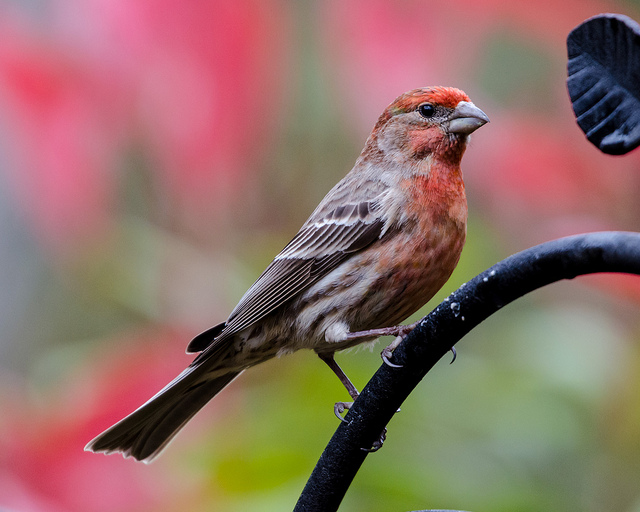
Small songbirds with rich, warbling song, which often includes parts of other birds’ songs, and their sweet, “tulip” call notes. Photo by Byron Chin.
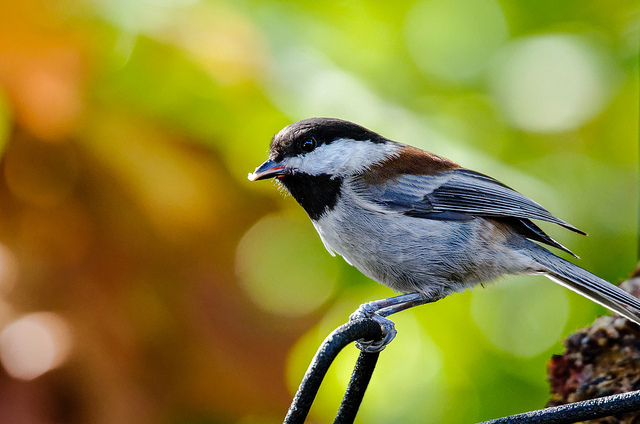
Active, sociable and noisy, you’ll find these birds at the heart of foraging flocks moving through tall conifers. Photo by Byron Chin.
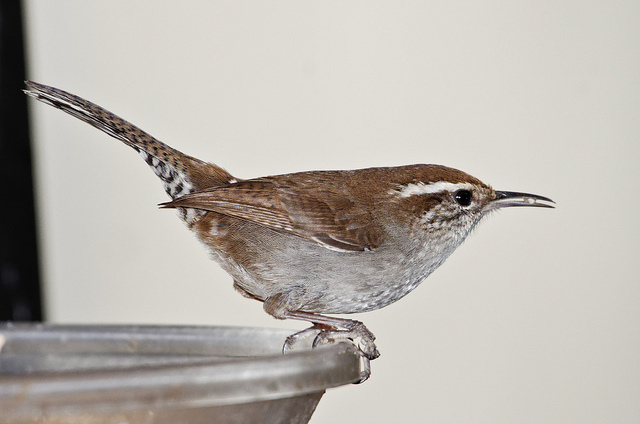
These master vocalists belt out a string of short whistles, warbles, burrs, and trills to attract mates and defend their territory, or scold visitors with raspy calls. Photo by Byron Chin.
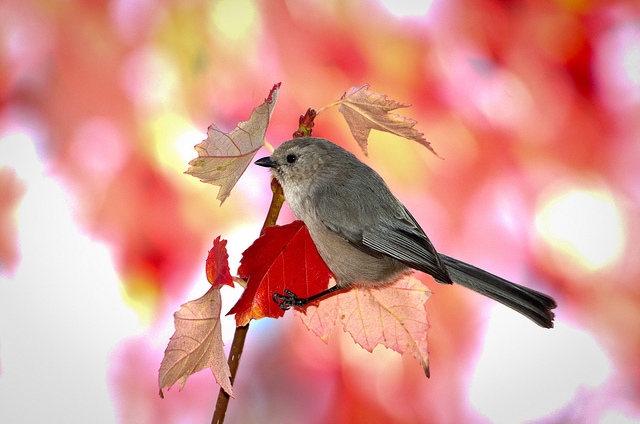
Social songbirds that twitter as they fly between shrubs and thickets. They move constantly, often hanging upside down to pick at insects or spiders on the undersides of leaves. Photo by Byron Chin.
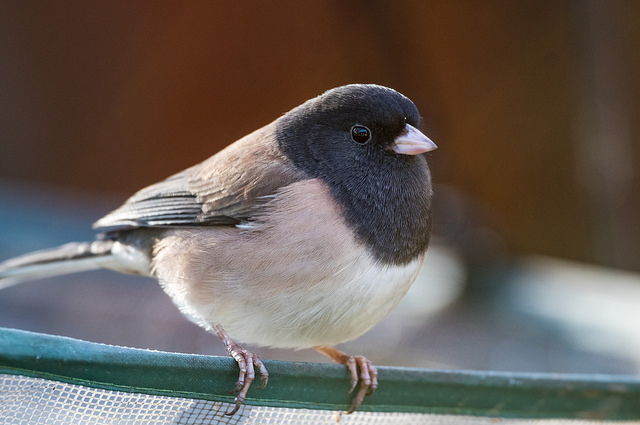
Flashy little sparrows that flit about forest floors. They’re easy to recognize by their crisp (though extremely variable) markings and the bright white tail feathers they habitually flash in flight. Photo by Christopher L. Wood
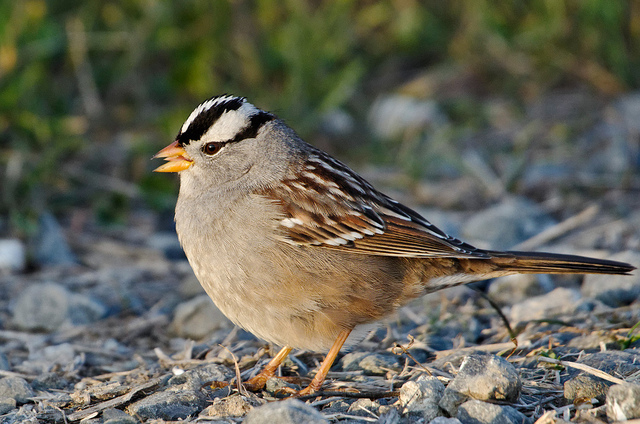
The smart black-and-white head, pale beak, and crisp gray breast combine for a dashing look – and make it one of the surest sparrow identifications in North America. Watch for flocks of these sparrows scurrying through brushy borders and overgrown fields, or coax them into the open with backyard feeders. As spring approaches, listen out for this bird’s thin, sweet whistle. Photo by Byron Chin.
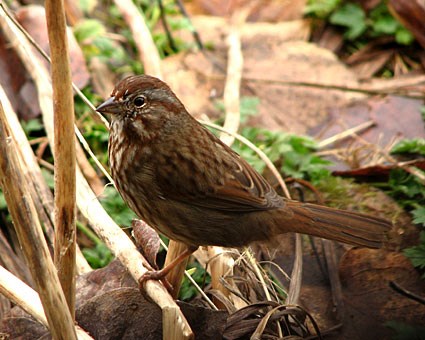
A rich, russet-and-gray bird with bold streaks down its white chest, the Song Sparrow is one of the most familiar North American sparrows. Don’t let the bewildering variety of regional differences this bird shows across North America deter you: it’s one of the first species you should suspect if you see a streaky sparrow in an open, shrubby, or wet area. If it perches on a low shrub, leans back, and sings a stuttering, clattering song, so much the better. Photo by Terri Guck.
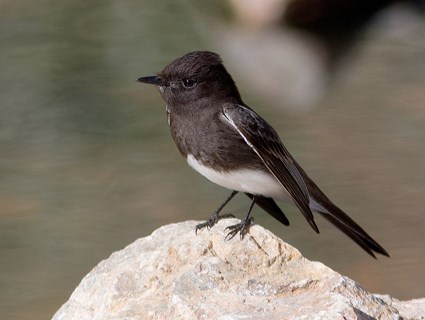
A dapper flycatcher with a sooty black body and crisp white belly. Photo by Lois Manowitz
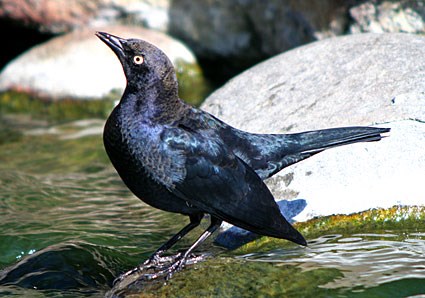
The male is glossy black, midnight blue, and metallic green. Females are a brown. Photo by Jamie Chavez.
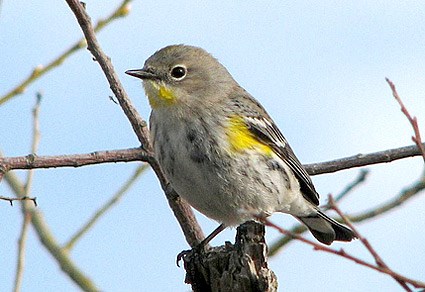
Yellow throat and side patches, White eye crescents, no pale eyebrow. Black streaking on sides of breast and flanks. Photo by Jon Rowley.
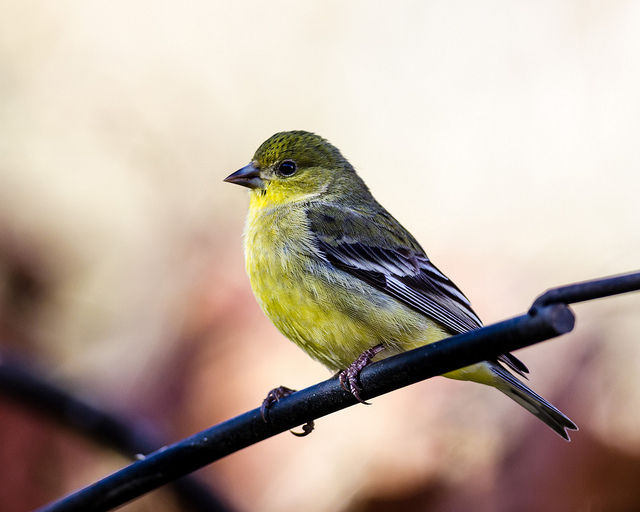
Jabbering clouds of yellow, green, and black Lesser Goldfinches gather in scrubby oak, cottonwood, and willows. Listen closely to their wheezy songs, which often include snippets from the songs of other birds. Photo by Byron Chin.
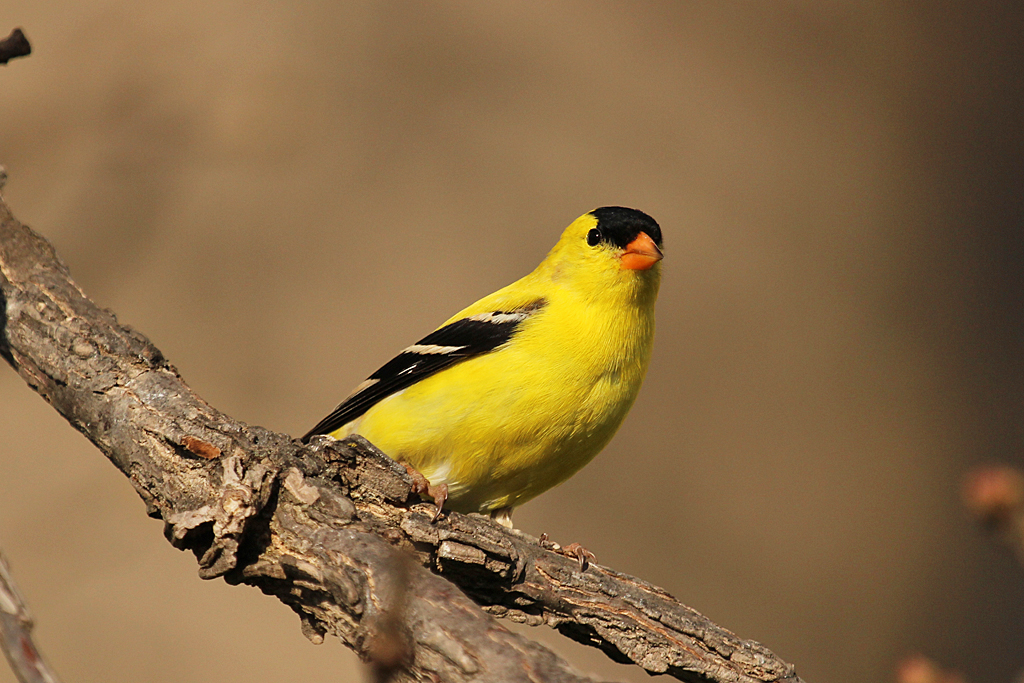
This handsome little finch is common at feeders. Spring males are brilliant yellow and shiny black with a bit of white. Females are more dull but identifiable by their conical bill; pointed, notched tail; wingbars; and lack of streaking. Photo by AllAboutBirds.org

With their iridescent emerald feathers and sparkling rose-pink throats, they are more like flying jewelry than birds. Photo by Byron Chin.
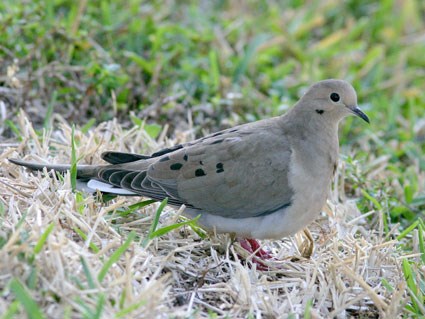
A graceful, slender-tailed, small-headed dove that’s common across the continent. Mourning Doves perch on telephone wires and forage for seeds on the ground; their flight is fast and bullet straight. Their soft, drawn-out calls sound like laments. When taking off, their wings make a sharp whistling or whinnying. Photo by Ken Schneider.
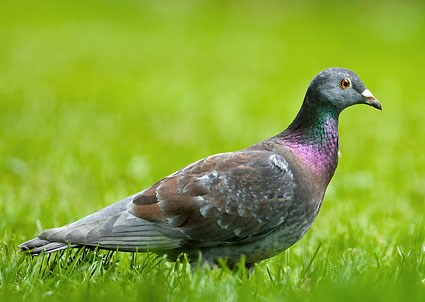
Variable patterns of gray and brownish, iridescent feathers on neck can be green and purple, Reddish eye, White cere at base of short bill. Photo by cdbtx
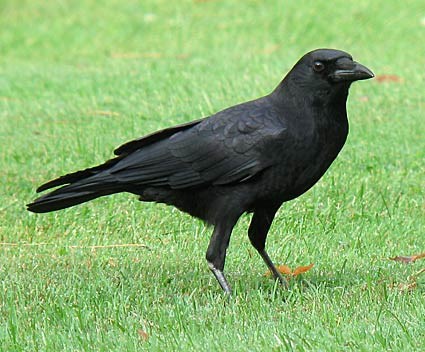
Large, intelligent, with a hoarse, cawing voices. They are common sights in treetops, fields, and roadsides, and in habitats ranging from open woods and empty beaches to town centers. Their flight style is unique, a patient, methodical flapping that is rarely broken up with glides. Photo by Kevin McGowan.
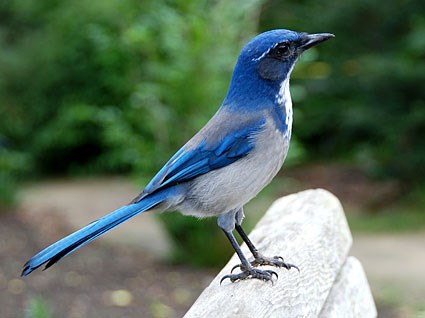
Deep azure blue with dusty gray-brown and white. The rounded, crestless head immediately sets it apart from Blue Jays and Steller’s Jays. These birds are a fixture of dry shrublands, oak woodlands, and pinyon pine-juniper forests, as well as conspicuous visitors to backyards. Photo by Lorcan Keating.
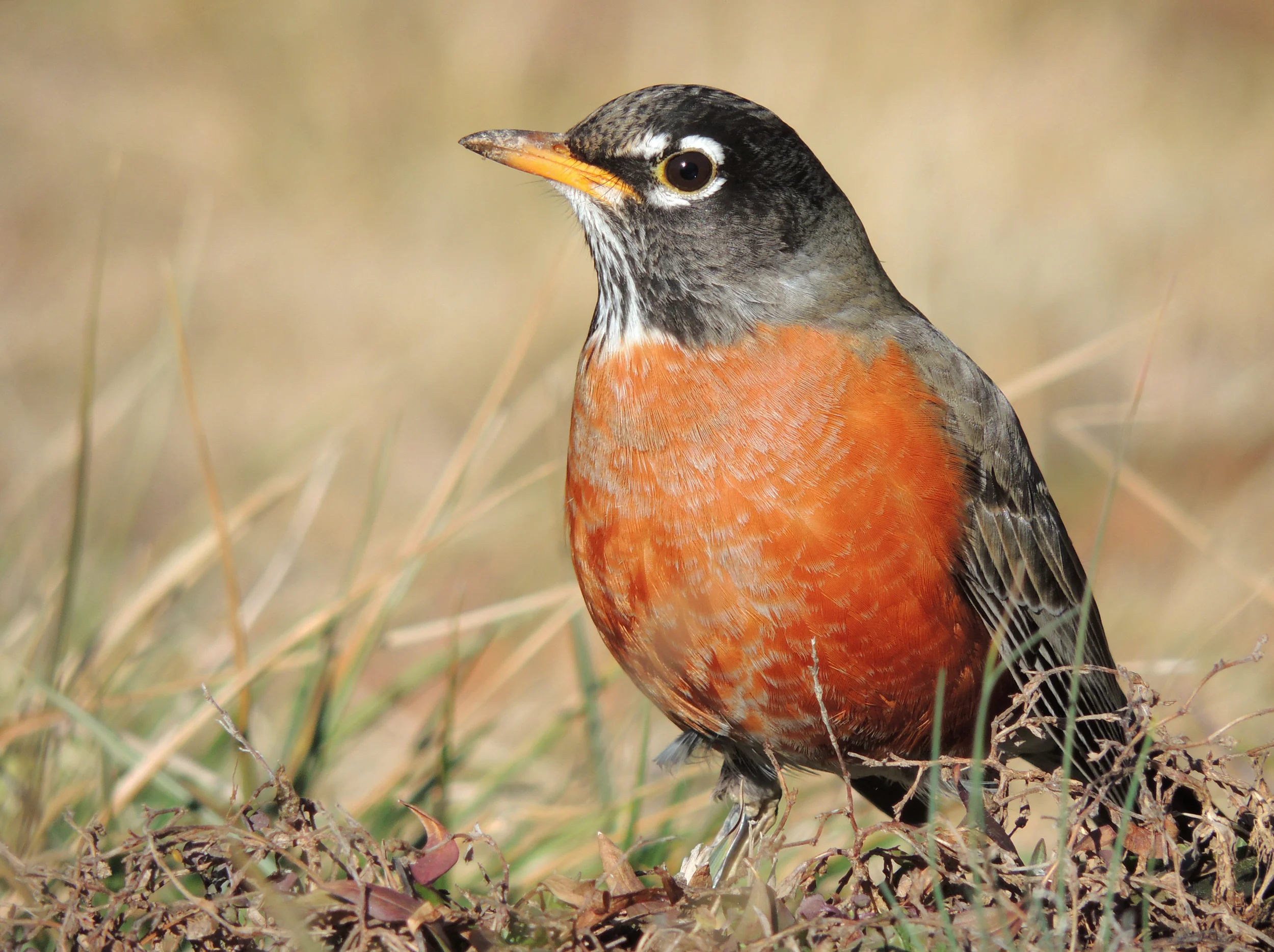
The quintessential early bird, common sights on lawns where you often see them tugging earthworms out of the ground. Robins are popular birds for their warm orange breast, cheery song, and early appearance at the end of winter. Photo by Dakota Lynch.
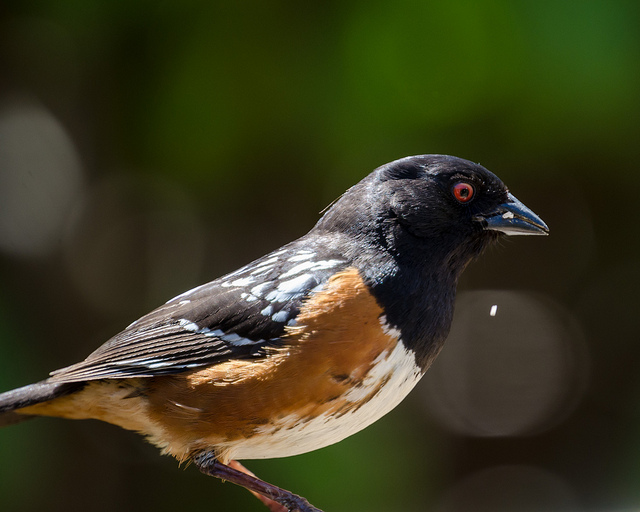
Your first encounter with a Towhee may be prompted by a tireless knocking at your window or car mirror: these common backyard birds habitually challenge their reflections. But Towhees are at heart birds of the tangled chaparral and other hot scrublands of California and Oregon. You’re as likely to hear their bright chip notes along a secluded trail as on your way out your front door. Photo by Byron Chin.
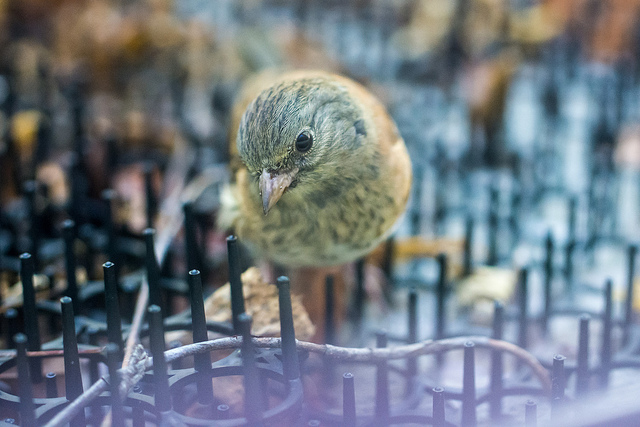
Photo by Byron Chin.
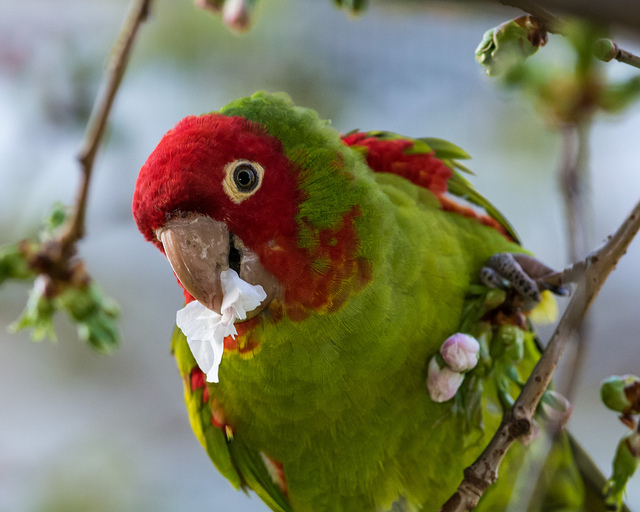
San Francisco boasts gaggles of parrots that fly to various groves throughout the city. These superstars, featured in the film "The Wild Parrots of Telegraph Hill," have become a vital food source for hawks. Photo by Bryon Chin.





















Birds in the Bay, Marshes, Creeks, & Reservoirs
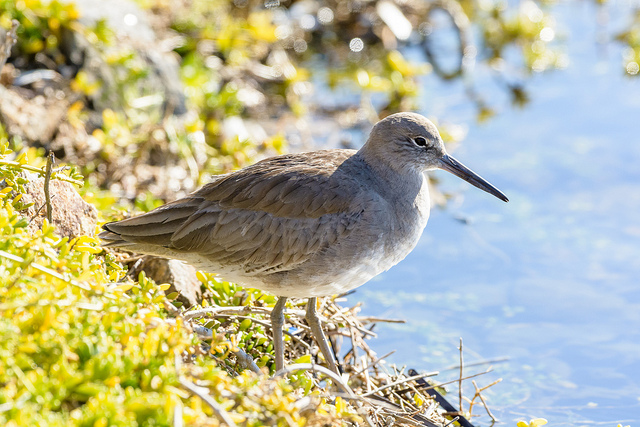
Piercing calls and distinctive wing markings make the otherwise subdued Willet one of our most conspicuous large shorebirds. Whether in mottled brown breeding plumage or gray winter colors, Willets in flight reveal a bold white and black stripe running the length of each wing. These long-legged, straight-billed shorebirds feed along beaches, mudflats, and rocky shores. Willets are common on most of our coastline—learn to recognize them and they’ll make a useful stepping-stone to identifying other shorebirds. Photo by Byron Chin.

A buoyant, large-headed duck that abruptly vanishes and resurfaces as it feeds, the tiny Bufflehead spends winters bobbing in bays, estuaries, reservoirs, and lakes. Males are striking black-and white from a distance. A closer look at the head shows glossy green and purple setting off the striking white patch. Females are a subdued gray-brown with a neat white patch on the cheek. Photo by Byron Chin.
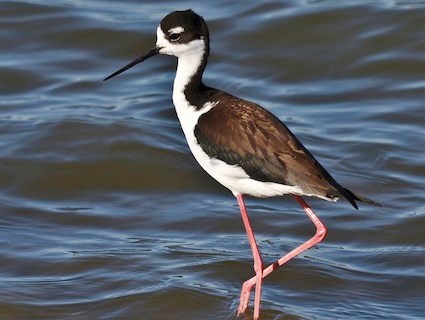
A striking black-and-white bird with very long, thin red legs, the Black-necked Stilt is found along the edges of shallow water in open country. Photo by Bob Gunderson.
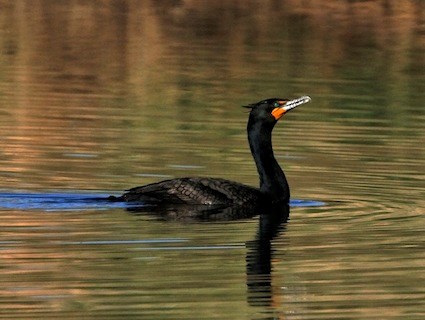
Gangly, prehistoric-looking, matte-black fishing bird with yellow-orange facial skin. They are relatives of frigatebirds and boobies and are a common sight around fresh and salt water across North America—perhaps attracting the most attention when they stand on docks, rocky islands, and channel markers, their wings spread out to dry. These solid, heavy-boned birds are experts at diving to catch small fish. Photo by David Stephens.
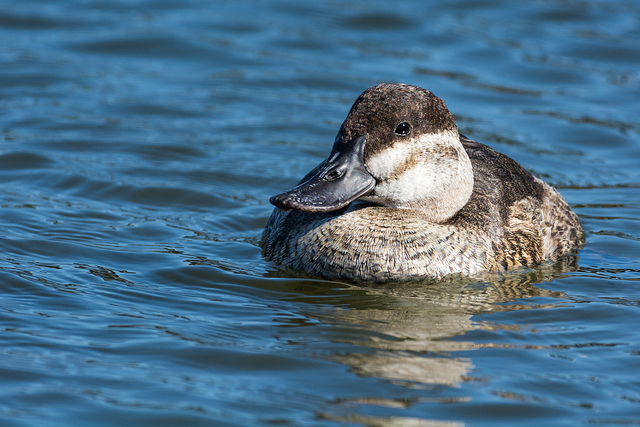
Compact, thick-necked waterfowl with seemingly oversized tails that they habitually hold upright. Breeding males are almost cartoonishly bold, with a sky-blue bill, shining white cheek patch, and gleaming chestnut body. They court females by beating their bill against their neck hard enough to create a swirl of bubbles in the water. Photo by Byron Chin.
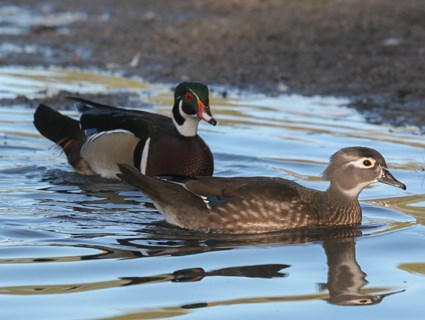
One of the most stunningly pretty of all waterfowl. Males are iridescent chestnut and green, with ornate patterns on nearly every feather; the elegant females have a distinctive profile and delicate white pattern around the eye. They are one of the few duck species equipped with strong claws that can grip bark and perch on branches. Photo by Christopher Wood.

If someone at a park is feeding bread to ducks, chances are there are Mallards in the fray. Perhaps the most familiar of all ducks. The male’s gleaming green head, gray flanks, and black tail-curl arguably make it the most easily identified duck. Photo by ashockenberry.
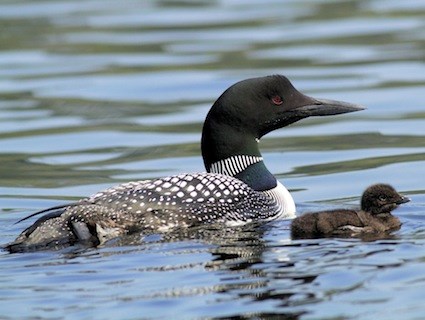
The eerie calls of Common Loons echo across lakes. Summer adults are regally patterned in black and white. In winter, they are plain gray above and white below, and you’ll find them close to shore on most seacoasts and a good many inland reservoirs and lakes. They are powerful, agile divers that catch small fish in fast underwater chases. They are less suited to land, and typically come ashore only to nest. Photo by Stuart Oikawa.
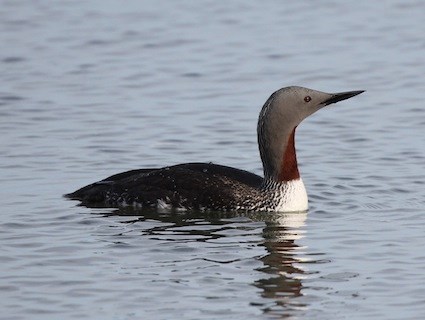
The smallest of the loons, it is distinctive among loons not only in size, but also in behavior, vocalizations, and locomotion. Photo by Jason Crotty
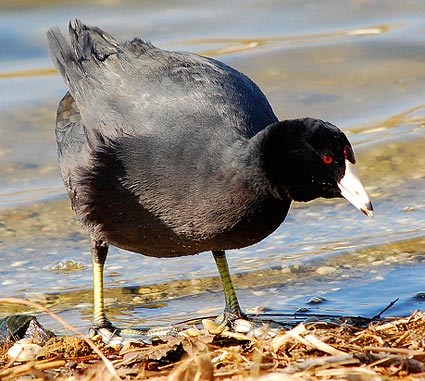
The waterborne American Coot is one good reminder that not everything that floats is a duck. A close look at a coot—that small head, those scrawny legs—reveals a different kind of bird entirely. Their dark bodies and white faces are common sights in nearly any open water across the continent, and they often mix with ducks. But they’re closer relatives of the gangly Sandhill Crane and the nearly invisible rails than of Mallards. Photo by Biltacular.
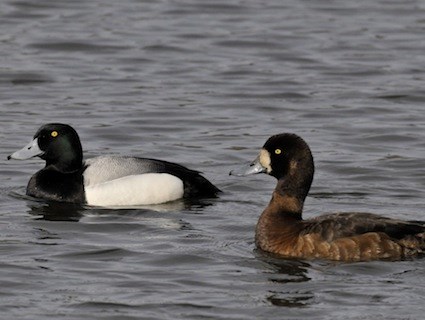
Found primarily along the seacoast and on large bodies of water. Photo by Bill Thompson.
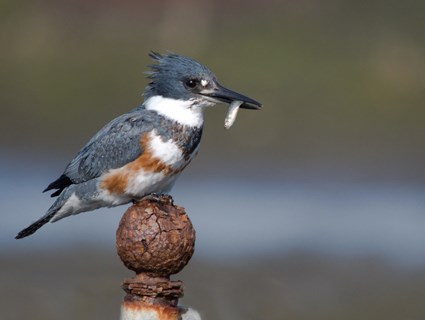
With its top-heavy physique, energetic flight, and piercing rattle, the Belted Kingfisher seems to have an air of self-importance as it patrols up and down rivers and shorelines. It nests in burrows along earthen banks and feeds almost entirely on aquatic prey, diving to catch fish and crayfish with its heavy, straight bill. These ragged-crested birds are a powdery blue-gray; males have one blue band across the white breast, while females have a blue and a chestnut band. Photo by Nick Chill.
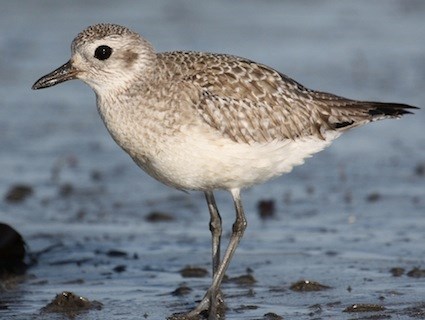
A large shorebird of coastal beaches, the Black-bellied Plover is striking in its black-and-white breeding plumage. Photo by Jason Crotty.
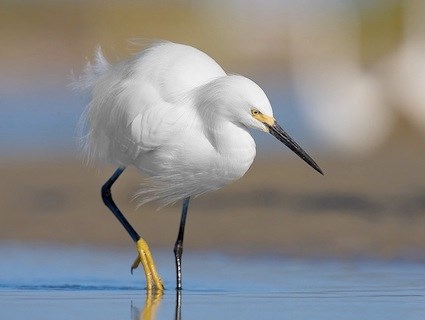
Among the most elegant of the herons, the slender Snowy Egret sets off immaculate white plumage with black legs and brilliant yellow feet. Those feet seem to play a role in stirring up or herding small aquatic animals as the egret forages. Breeding Snowy Egrets grow filmy, curving plumes that once fetched astronomical prices in the fashion industry, endangering the species. Early conservationists rallied to protect egrets by the early twentieth century, and this species is once again a common sight in shallow coastal wetlands. Photo by Bill Majaros.
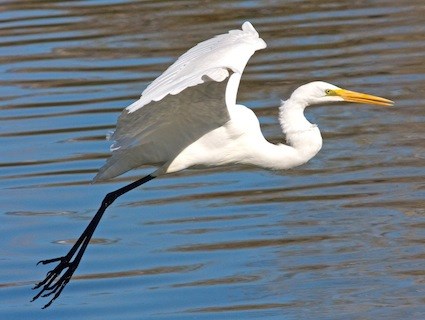
A dazzling sight in many a North American wetland. Slightly smaller and more svelte than a Great Blue Heron, these are still large birds with impressive wingspans. They hunt in classic heron fashion, standing immobile or wading through wetlands to capture fish with a deadly jab of their yellow bill. Great Egrets were hunted nearly to extinction for their plumes in the late nineteenth century, sparking conservation movements and some of the first laws to protect birds. Photo by Lois Manowitz.
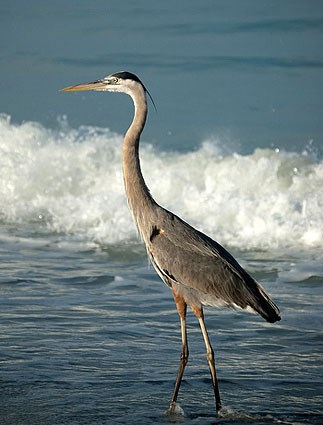
Whether poised at a river bend or cruising the coastline with slow, deep wingbeats, the Great Blue Heron is a majestic sight. This stately heron with its subtle blue-gray plumage often stands motionless as it scans for prey or wades belly deep with long, deliberate steps. They may move slowly, but Great Blue Herons can strike like lightning to grab a fish or snap up a gopher. In flight, look for this widespread heron’s tucked-in neck and long legs trailing out behind. Photo by Marie Reed.

A large shorebird with a long, upturned bill. It breeds in the northern prairies, amongst grasslands and scattered wetlands. Photo by Gary Tyson.
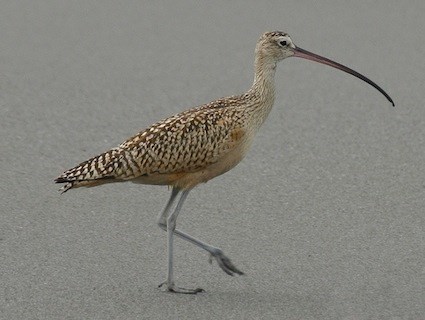
North America's largest shorebird, the Long-billed Curlew breeds in the grasslands of the Great Plains and Great Basin. Photo by Cameron Rognan.
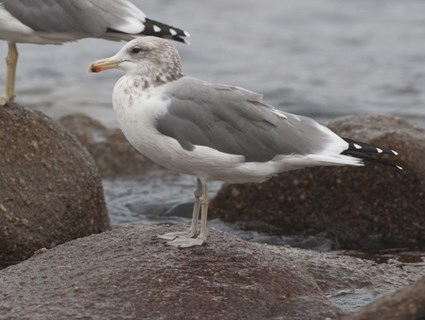
A common winter gull of the West Coast, the California Gull breeds inland across large areas of the West. It can be found in parking lots and lakes from California to Manitoba. Photo by Christopher Wood.
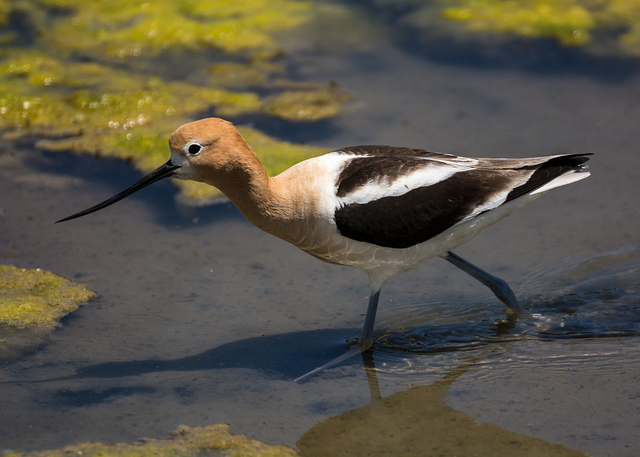
Photo by Byron Chin.
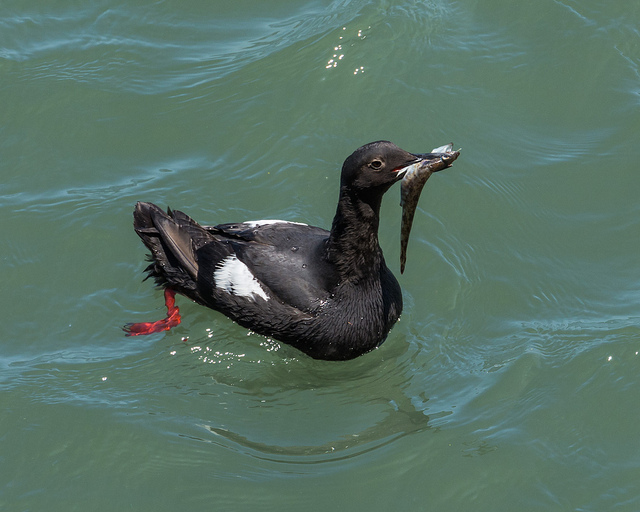
A seabird of the northern Pacific, the Pigeon Guillemot is found along rocky coasts from Alaska to California. It spends more time close to shore than other members of the puffin family. Photo by Byron Chin.
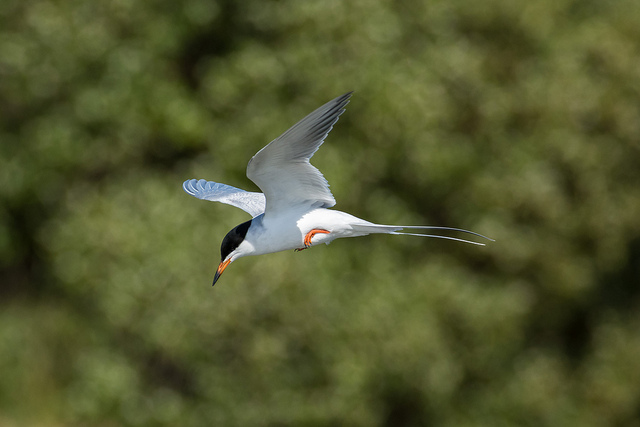
One of several medium-sized terns that are similar in appearance, they breed primarily in marshes and winters along the coasts. The comma-shaped black ear patch in winter plumage is distinctive, but some other plumages are very confusing. Photo by Byron Chin.

A familiar and widespread goose with a black head and neck, white chinstrap, light tan to cream breast and brown back. Has increased in urban and suburban areas in recent years; just a decade or two after people intentionally introduced or reintroduced “giant” Canada Geese to various areas, they are often considered pests. Photo by Kevin Bolton.

A rich, russet-and-gray bird with bold streaks down its white chest, the Song Sparrow is one of the most familiar North American sparrows. Don’t let the bewildering variety of regional differences this bird shows across North America deter you: it’s one of the first species you should suspect if you see a streaky sparrow in an open, shrubby, or wet area. If it perches on a low shrub, leans back, and sings a stuttering, clattering song, so much the better. Photo by Terri Guck.
























SUGGESTED PLACES TO VIEW THESE BIRDS: Richardson Bay Audubon Center & Sanctuary, Corte Madera Ecological Reserve, China Camp State Park, Gallinas Creek, Novato Creek Marsh, Rush Creek Marsh, San Rafael Bayfront, Triangle Marsh (Ring Mountain in Corte Madera.), Bolinas Lagoon, Tomales Bay, Kent Lake, Abbott's Lagoon, Olema Creek, Arroyo del Corte Madera, Rodeo Lagoon
Woodland Birds
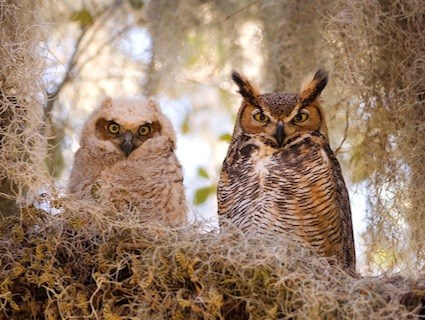
With its long, earlike tufts, intimidating yellow-eyed stare, and deep hooting voice, the Great Horned Owl is the quintessential owl of storybooks. This powerful predator can take down birds and mammals even larger than itself, but it also dines on daintier fare such as tiny scorpions, mice, and frogs. It’s one of the most common owls in North America, equally at home in deserts, wetlands, forests, grasslands, backyards, cities, and almost any other semi-open habitat between the Arctic and the tropics. Photo by Donald Thompson.
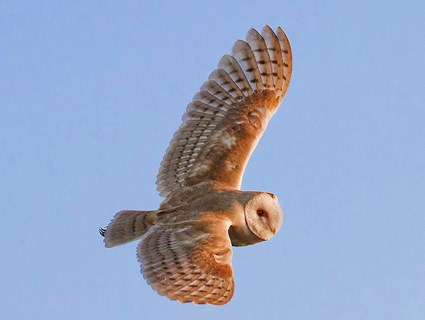
Ghostly pale and strictly nocturnal, Barn Owls are silent predators of the night world. Lanky, with a whitish face, chest, and belly, and buffy upperparts, this owl roosts in hidden, quiet places during the day. By night, they hunt on buoyant wingbeats in open fields and meadows. You can find them by listening for their eerie, raspy calls, quite unlike the hoots of other owls. Despite a worldwide distribution, Barn Owls are declining in parts of their range due to habitat loss. Photo by Conrad Tan.
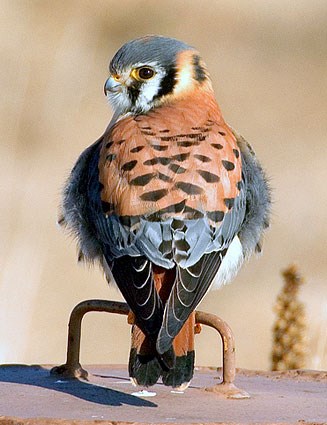
North America’s littlest falcon, the American Kestrel packs a predator’s fierce intensity into its small body. It's one of the most colorful of all raptors: the male’s slate-blue head and wings contrast elegantly with his rusty-red back and tail; the female has the same warm reddish on her wings, back, and tail. Hunting for insects and other small prey in open territory, kestrels perch on wires or poles, or hover facing into the wind, flapping and adjusting their long tails to stay in place. Kestrels are declining in parts of their range; you can help them by putting up nest boxes. Photo by Michael Hogan.
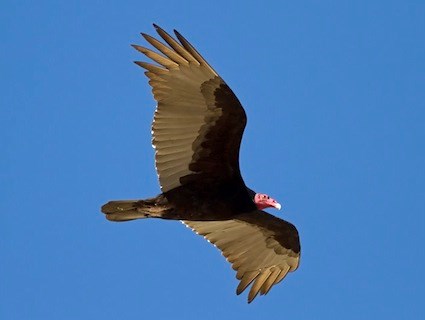
If you’ve gone looking for raptors on a clear day, your heart has probably leaped at the sight of a large, soaring bird in the distance– perhaps an eagle or osprey. But if it's soaring with its wings raised in a V and making wobbly circles, it's likely a Turkey Vulture. These birds ride thermals in the sky and use their keen sense of smell to find fresh carcasses. They are a consummate scavenger, cleaning up the countryside one bite of their sharply hooked bill at a time, and never mussing a feather on their bald heads. Photo by Ned Harris.
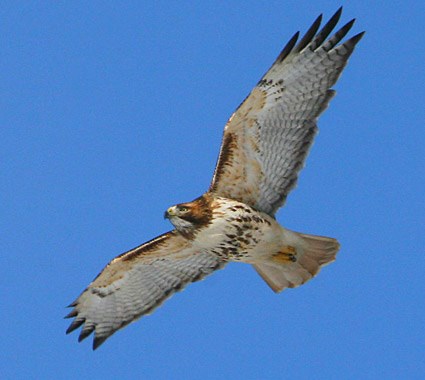
This is probably the most common hawk in North America. If you’ve got sharp eyes you’ll see several individuals on almost any long car ride, anywhere. Red-tailed Hawks soar above open fields, slowly turning circles on their broad, rounded wings. Other times you’ll see them atop telephone poles, eyes fixed on the ground to catch the movements of a vole or a rabbit, or simply waiting out cold weather before climbing a thermal updraft into the sky. Photo by askockenberry.
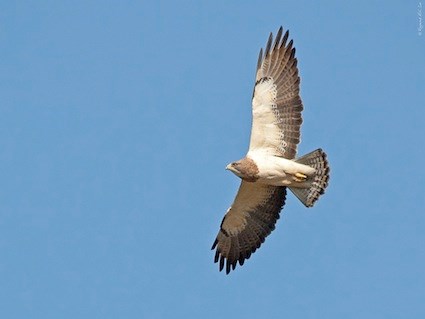
A classic species of the open country of the Great Plains and the West, Swainson’s Hawks soar on narrow wings or perch on fence posts and irrigation spouts. These elegant gray, white, and brown hawks hunt rodents in flight, wings held in a shallow V, or even run after insects on the ground. In fall, they take off for Argentine wintering grounds—one of the longest migrations of any American raptor—forming flocks of hundreds or thousands as they travel. Photo by Raymond Lee.

A medium-sized raptor of open grasslands, the White-tailed Kite is readily identified by its bright plumage and its habit of hovering while hunting for small mammals. Photo by Larry and Dena.
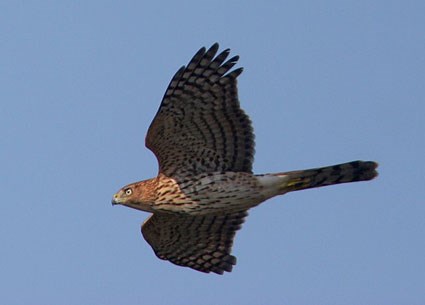
Among the bird world’s most skillful fliers, Cooper’s Hawks are common woodland hawks that tear through cluttered tree canopies in high speed pursuit of other birds. You’re most likely to see one prowling above a forest edge or field using just a few stiff wingbeats followed by a glide. With their smaller lookalike, the Sharp-shinned Hawk, Cooper’s Hawks make for famously tricky identifications. Both species are sometimes unwanted guests at bird feeders, looking for an easy meal (but not one of sunflower seeds). Photo by Gerry Dewaghe.
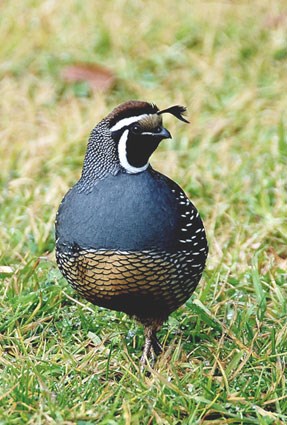
The California Quail is a handsome, round soccer ball of a bird with a rich gray breast, intricately scaled underparts, and a curious, forward-drooping head plume. Its stiffly accented Chi-ca-go call is a common sound of the chaparral and other brushy areas of California and the Northwest. Often seen scratching at the ground in large groups or dashing forward on blurred legs, California Quail are common but unobtrusive. They flush to cover if scared, so approach them gently. Photo by quasimodo4502.
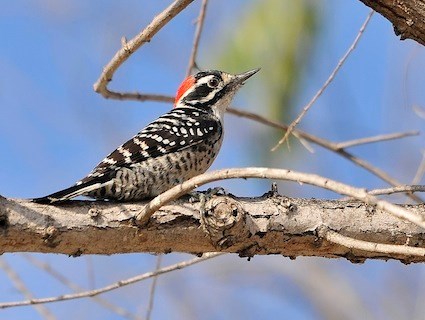
A small woodpecker confined primarily to the oak woodlands of California. Photo bay Mike Thirkell.

Your first encounter with a Towhee may be prompted by a tireless knocking at your window or car mirror: these common backyard birds habitually challenge their reflections. But Towhees are at heart birds of the tangled chaparral and other hot scrublands of California and Oregon. You’re as likely to hear their bright chip notes along a secluded trail as on your way out your front door. Photo by Byron Chin.

Typically seen sending up a spray of leaf litter as they kick around in search of food, Fox Sparrows are dark, splotchy sparrows of dense thickets. Named for the rich red hues that many Fox Sparrows wear, this species is nevertheless one of our most variable birds, with four main groups that can range from foxy red to gray to dark brown. Since they breed primarily in remote areas, many people see them in winter when the birds move into backyard thickets. Photo by Ken Phenicle, Jr.

The quintessential early bird, common sights on lawns where you often see them tugging earthworms out of the ground. Robins are popular birds for their warm orange breast, cheery song, and early appearance at the end of winter. Photo by Dakota Lynch.
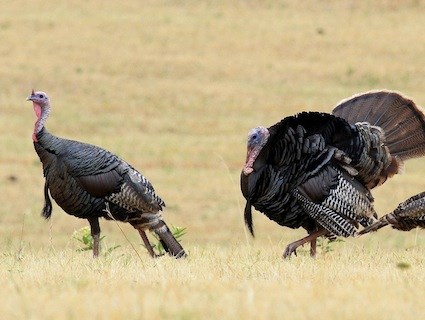
Most North American kids learn turkey identification early, by tracing outlines of their hands to make Thanksgiving cards. These big, spectacular birds are an increasingly common sight the rest of the year, too, as flocks stride around woods and clearings like miniature dinosaurs. Courting males puff themselves into feathery balls and fill the air with exuberant gobbling. Photo by Reddirtpics.

A tiny bird seemingly overflowing with energy, the Ruby-crowned Kinglet forages almost frantically through lower branches of shrubs and trees. Its habit of constantly flicking its wings is a key identification clue. Smaller than a warbler or chickadee, this plain green-gray bird has a white eyering and a white bar on the wing. Alas, the male’s brilliant ruby crown patch usually stays hidden—your best chance to see it is to find an excited male singing in spring or summer. Photo by Ganesh Jayamaran.
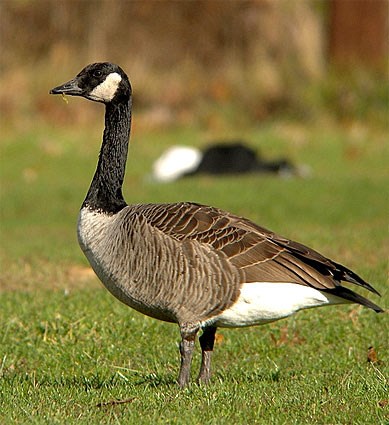
A familiar and widespread goose with a black head and neck, white chinstrap, light tan to cream breast and brown back. Has increased in urban and suburban areas in recent years; just a decade or two after people intentionally introduced or reintroduced “giant” Canada Geese to various areas, they are often considered pests. Photo by Kevin Bolton.
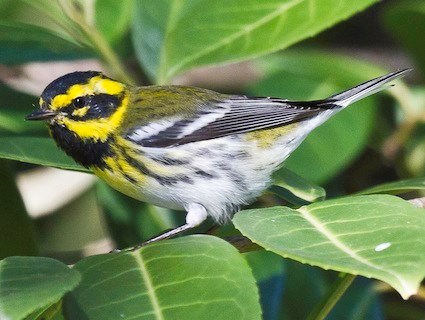
A bird of the Pacific Northwest, the Townsend's Warbler nests in coniferous forests from Alaska to Oregon. It winters in two distinct areas: in a narrow strip along the Pacific Coast, and in Mexico and Central America. Photo by Bob Gunderson.
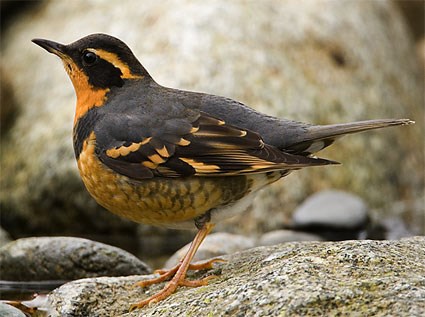
Simple, ringing song gives a voice to the quiet forests of the Pacific Northwest, with their towering conifers and wet understories of ferns, shrubs, and mosses. Catch a glimpse of this shy bird and you’ll see a handsome thrush with a slaty gray back and breast band set against burnt-orange breast and belly. They forage for insects in summer and switch to berries and seeds in winter. Photo by John Tubbs.
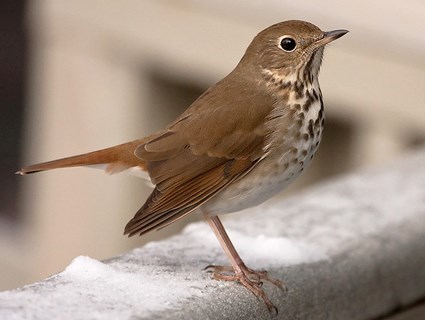
An unassuming bird with a lovely, melancholy song, the Hermit Thrush lurks in the understories of far northern forests in summer and is a frequent winter companion across much of the country. It forages on the forest floor by rummaging through leaf litter or seizing insects with its bill. The Hermit Thrush has a rich brown upper body and smudged spots on the breast, with a reddish tail that sets it apart from similar species in its genus. Photo by Isabel Cutler.
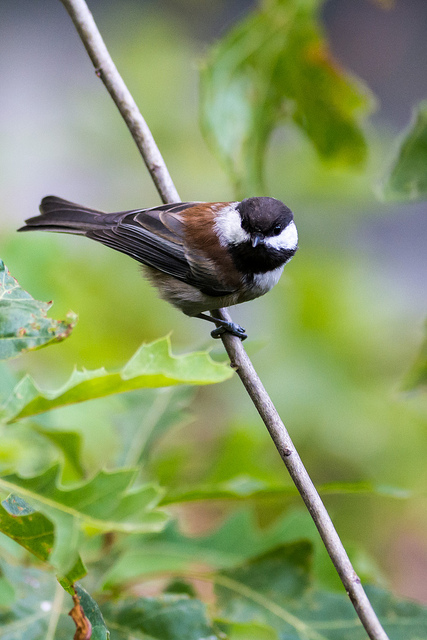
Active, sociable and noisy, you’ll find these birds at the heart of foraging flocks moving through tall conifers. Photo by Byron Chin.




















SUGGESTED PLACES TO VIEW THESE BIRDS: Muir Woods, Mt. Tamalpias, Mount Burdell
Birds in the Fields
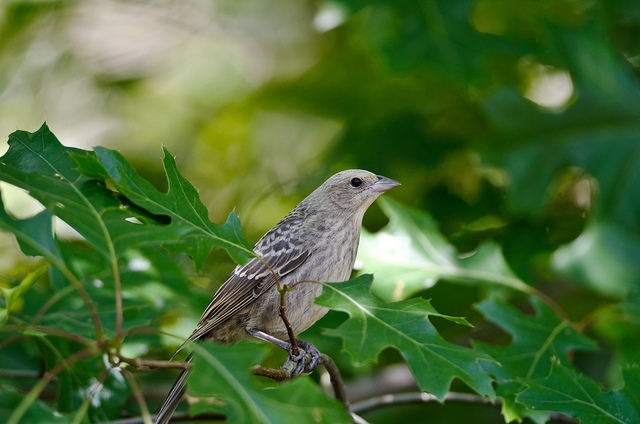
This is a young cowbird. Adults are brown-headed and stocky blackbirds. Females forgo building nests and instead put all their energy into producing eggs, sometimes more than three dozen a summer. These they lay in the nests of other birds, abandoning their young to foster parents, usually at the expense of at least some of the host’s own chicks. Photo by Byron Chin.
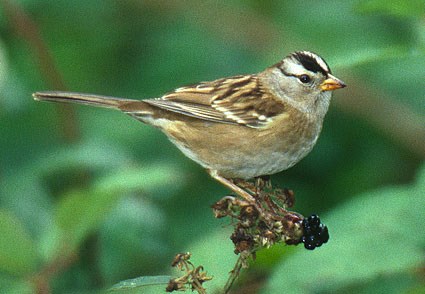
White-crowned Sparrows appear each winter over much of North America to grace our gardens and favorite trails (they live in parts of the West year-round). The smart black-and-white head, pale beak, and crisp gray breast combine for a dashing look – and make it one of the surest sparrow identifications in North America. Watch for flocks of these sparrows scurrying through brushy borders and overgrown fields, or coax them into the open with backyard feeders. As spring approaches, listen out for this bird’s thin, sweet whistle. Photo by lee.karney2.
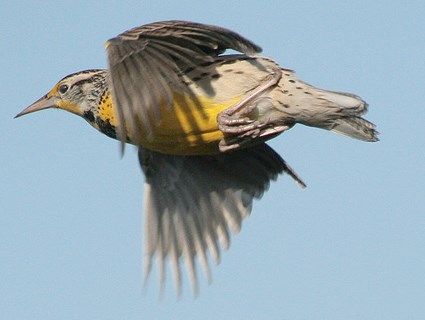
The buoyant, flutelike melody of the Western Meadowlark ringing out across a field can brighten anyone’s day. Meadowlarks are often more easily heard than seen, unless you spot a male singing from a fence post. This colorful member of the blackbird family flashes a vibrant yellow breast crossed by a distinctive, black, V-shaped band. Look and listen for these stout ground feeders in grasslands, meadows, pastures, and along marsh edges throughout the West and Midwest, where flocks strut and feed on seeds and insects. Photo by Cameron Rognan.

A familiar and widespread goose with a black head and neck, white chinstrap, light tan to cream breast and brown back. Has increased in urban and suburban areas in recent years; just a decade or two after people intentionally introduced or reintroduced “giant” Canada Geese to various areas, they are often considered pests. Photo by Kevin Bolton.

The California Quail is a handsome, round soccer ball of a bird with a rich gray breast, intricately scaled underparts, and a curious, forward-drooping head plume. Its stiffly accented Chi-ca-go call is a common sound of the chaparral and other brushy areas of California and the Northwest. Often seen scratching at the ground in large groups or dashing forward on blurred legs, California Quail are common but unobtrusive. They flush to cover if scared, so approach them gently. Photo by quasimodo4502.

Most North American kids learn turkey identification early, by tracing outlines of their hands to make Thanksgiving cards. These big, spectacular birds are an increasingly common sight the rest of the year, too, as flocks stride around woods and clearings like miniature dinosaurs. Courting males puff themselves into feathery balls and fill the air with exuberant gobbling. Photo by Reddirtpics.
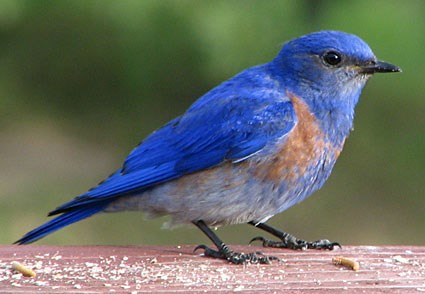
Brilliant blue-and-rust Western Bluebirds sit on low perches and swoop lightly to the ground to catch insects. Deep blue, rusty, and white, males are considerably brighter than the gray-brown, blue-tinged females. This small thrush nests in holes in trees or nest boxes and often gathers in small flocks to feed on insects or berries, giving their quiet, chortling calls. You can help out Western Bluebirds by placing nest boxes in your yard or park. Photo by Barbara Pursell.

A dapper flycatcher with a sooty black body and crisp white belly. Photo by Lois Manowitz
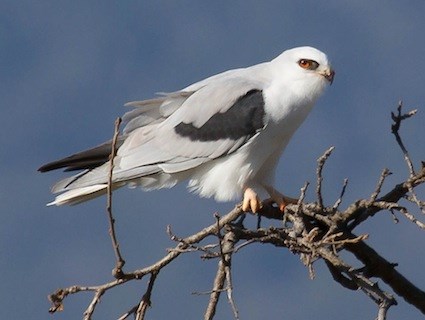
A medium-sized raptor of open grasslands, the White-tailed Kite is readily identified by its bright plumage and its habit of hovering while hunting for small mammals. Photo by Larry and Dena.









SUGGESTED PLACES TO VIEW THESE BIRDS: Mt. Vision, Muir Woods, Mt. Tam, Hawk Hill (Marin Headlands), Mt. Burdell Open Space Preserve
Birds at the Ocean
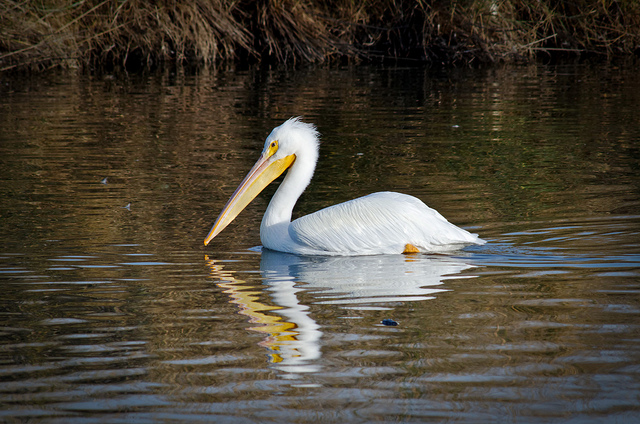
One of the largest North American birds, the American White Pelican is majestic in the air. The birds soar with incredible steadiness on broad, white-and-black wings. Their large heads and huge, heavy bills give them a prehistoric look. On the water they dip their pouched bills to scoop up fish, or tip-up like an oversized dabbling duck. Sometimes, groups of pelicans work together to herd fish into the shallows for easy feeding. Look for them on inland lakes in summer and near coastlines in winter. Photo by Byron Chin.
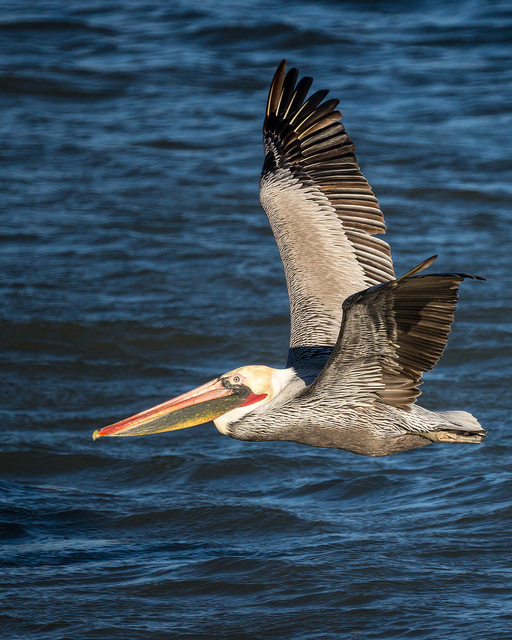
The Brown Pelican is a comically elegant bird with an oversized bill, sinuous neck, and big, dark body. Squadrons glide above the surf along southern and western coasts, rising and falling in a graceful echo of the waves. They feed by plunge-diving from high up, using the force of impact to stun small fish before scooping them up. They are fairly common today—an excellent example of a species’ recovery from pesticide pollution that once placed them at the brink of extinction. Photo by Byron Chin.
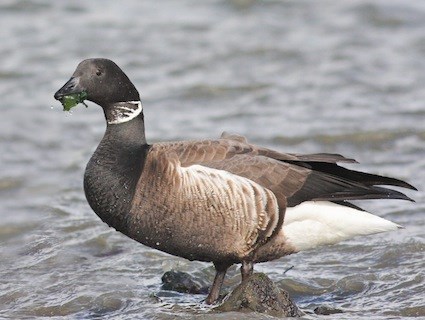
An abundant small goose of the ocean shores, the Brant breeds in the high Arctic tundra and winters along both coasts. The Brant along the Pacific Coast have black bellies and were at one time considered a separate species. Photo by Hjhipster.
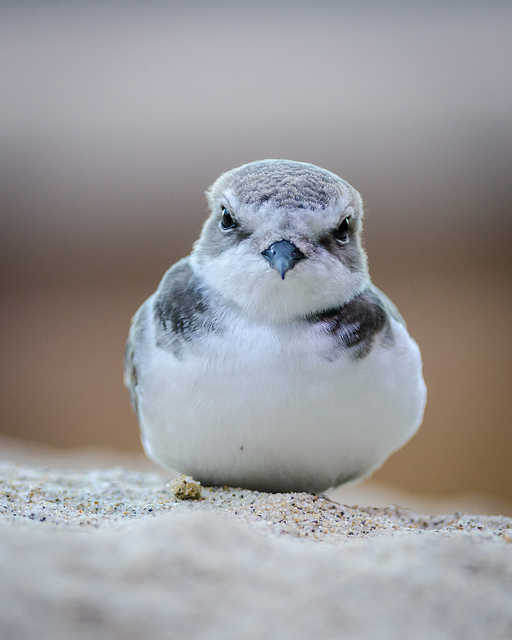
A small plover of beaches and barren ground, the Snowy Plover can be found across North and South America, Eurasia, and Africa. In North America it is restricted to the Gulf and Pacific coasts of the United States, and scattered inland localities from Saskatchewan to California and Texas. Photo by Byron Chin.
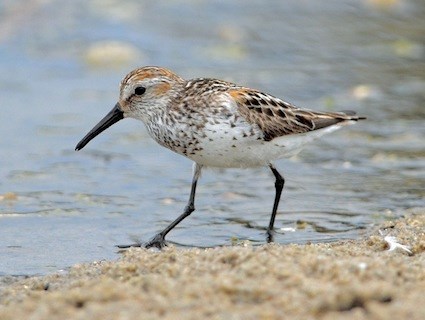
Small sandpiper. Short neck. Moderately long bill, with slight droop. Moderately long legs. Black center of rump and tail. Legs black. Back gray-brown with some reddish. Chest usually only lightly marked. In breeding plumage has chestnut on back, crown, and back of face. Short webbing between toes (hard to see). Photo by Photosuze.

A large cormorant of the Pacific Coast, the Brandt's Cormorant is found only in marine environments. Photo by Maureen Sullivan.
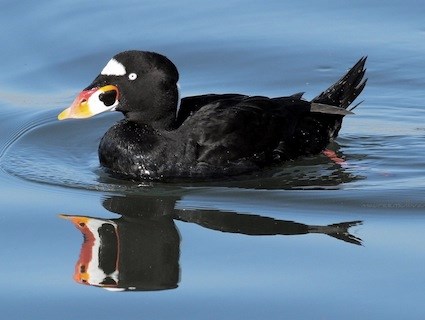
A black-and-white seaduck common on the Pacific and Atlantic coasts in winter, the Surf Scoter has a boldly patterned head that is the basis for its colloquial name "skunk-headed coot." Photo by Maureen Sullivan.
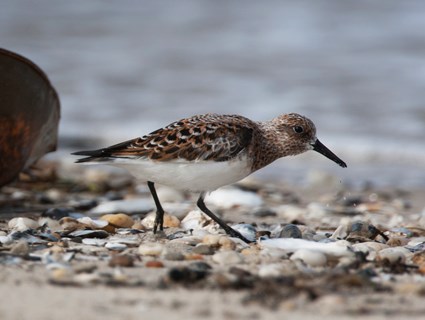
The Sanderling’s black legs blur as it runs back and forth on the beach, picking or probing for tiny prey in the wet sand left by receding waves. Sanderlings are medium-sized “peep” sandpipers recognizable by their pale nonbreeding plumage, black legs and bill, and obsessive wave-chasing habits. Learn this species, and you’ll have an aid in sorting out less common shorebirds. These extreme long-distance migrants breed only on High Arctic tundra, but during the winter they live on most of the sandy beaches of the world. Photo by Christopher Wood.

Whether poised at a river bend or cruising the coastline with slow, deep wingbeats, the Great Blue Heron is a majestic sight. This stately heron with its subtle blue-gray plumage often stands motionless as it scans for prey or wades belly deep with long, deliberate steps. They may move slowly, but Great Blue Herons can strike like lightning to grab a fish or snap up a gopher. In flight, look for this widespread heron’s tucked-in neck and long legs trailing out behind. Photo by Marie Reed.
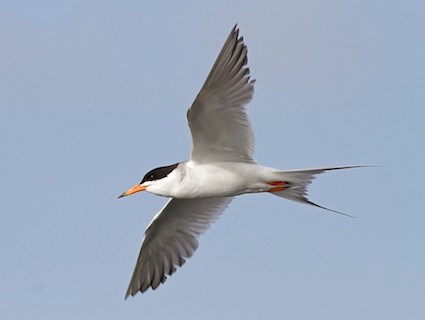
Whether poised at a river bend or cruising the coastline with slow, deep wingbeats, the Great Blue Heron is a majestic sight. This stately heron with its subtle blue-gray plumage often stands motionless as it scans for prey or wades belly deep with long, deliberate steps. They may move slowly, but Great Blue Herons can strike like lightning to grab a fish or snap up a gopher. In flight, look for this widespread heron’s tucked-in neck and long legs trailing out behind. Photo by Marie Reed.

A common winter gull of the West Coast, the California Gull breeds inland across large areas of the West. It can be found in parking lots and lakes from California to Manitoba. Photo by Byron Chin.











SUGGESTED PLACES TO VIEW THESE BIRDS: Kehoe Beach (Point Reyes National Seashore), Drake's Beach, Limantour, Palomarin Beach, Stinson Beach, Bolinas Beach

















